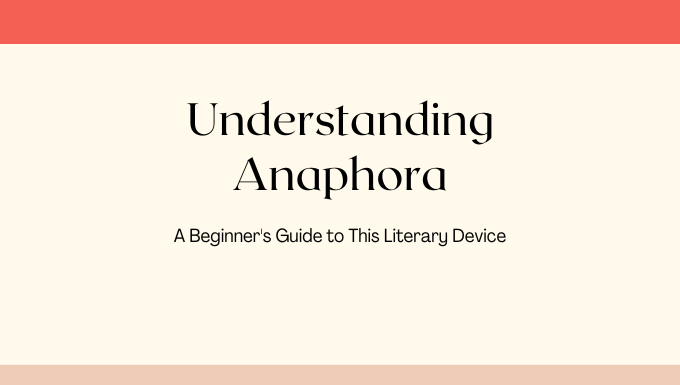
Table of Contents
Introduction to Anaphora
If you’ve ever read a piece of writing that left a strong impression because certain phrases were repeated, you’ve likely encountered anaphora. Anaphora, in the simplest terms, is a literary device where a word or a group of words is repeated at the beginning of multiple sentences or clauses. It’s a technique used by writers to emphasize a point, create rhythm, and make their writing more memorable.
Why Do Writers Use Anaphora?
- To Emphasize a Point: By repeating words, an author can highlight an important idea or theme in their writing.
- To Create Rhythm: Repetition can give a musical quality to prose or poetry, making it more pleasant to read or listen to.
- To Evoke Emotion: Anaphora can stir emotions in the reader, especially when the repeated phrase is charged with feeling.
Examples of Anaphora in Literature
- Martin Luther King Jr.’s “I Have a Dream” Speech: This historic speech uses anaphora effectively. The repeated use of “I have a dream” emphasizes the vision and hope behind his words.
- Charles Dickens’ “A Tale of Two Cities”: The famous opening line, “It was the best of times, it was the worst of times,” is a classic example of anaphora that sets the tone for the novel.
- In poetry, Maya Angelou’s “Still I Rise” provides an example of anaphora. The poem repeatedly uses phrases like “You may…” to emphasize resilience and defiance in the face of oppression and discrimination.
These examples show how anaphora can be used to create a powerful emotional impact and leave a lasting impression on the audience.
How to Identify Anaphora
Look for the repetition of words or phrases at the beginning of sentences or clauses. If you notice that the same words keep cropping up in the same position, you’re likely seeing anaphora in action.
Using Anaphora in Your Writing
- Choose Your Words Carefully: The repeated phrase should be meaningful and relevant to your message.
- Maintain Consistency: Ensure that the repeated phrase appears at the start of successive lines or sentences.
- Balance is Key: Too much repetition can be overbearing, so use anaphora sparingly to maintain its impact.
Tips for Beginners
- Start Small: Try using anaphora in a short poem or a brief paragraph to get a feel for how it works.
- Read Aloud: Hearing your writing can help you gauge the rhythm and impact of your anaphora.
- Experiment: Don’t be afraid to play around with different phrases and structures.
Final Thoughts
Anaphora can be a powerful tool in your writing arsenal. It can transform ordinary sentences into memorable, rhythmical, and impactful pieces of writing. As with any literary device, the key lies in using it effectively and appropriately. Happy writing!
Anaphora FAQs
Anaphora is a powerful literary and rhetorical device characterized by the repetition of a word or phrase at the beginning of successive sentences, clauses, or phrases. Here are some frequently asked questions about anaphora:
- What is Anaphora?
Anaphora involves repeating a word or phrase in successive clauses or sentences, primarily to emphasize a particular idea or theme, create rhythm, and elicit an emotional response from the reader or listener. - What is the Purpose of Anaphora?
Anaphora serves several purposes. It can reinforce or emphasize a concept, create a sense of urgency or a call to action, and add rhythm to the text. In speeches, it is often used to rally a crowd and focus attention on key points. - How Does Anaphora Differ from Epistrophe?
While anaphora repeats words at the beginning of sentences or clauses, epistrophe (or epiphora) involves the repetition of words at the end of sentences or clauses. Both are used for rhetorical emphasis but in different positions in the text. - Can Anaphora Contain Variations?
Yes, anaphora can include slight variations. For example, a phrase can start with the same few words but end differently in each occurrence, adding diversity while maintaining the repetitive effect. - How Do You Use Anaphora in Writing?
To use anaphora effectively, you should identify what you want to emphasize in your text and then decide on the most effective word or phrase for repetition. It’s important to ensure that the repetition feels deliberate and meaningful, contributing to the overall rhythm and structure of your writing. - What Are Some Famous Examples of Anaphora?
Anaphora is prevalent in literature, speeches, and songs. Notable examples include Martin Luther King Jr.’s “I Have a Dream” speech, where phrases like “let freedom ring” are repeated, and Charles Dickens’ “A Tale of Two Cities,” which uses anaphora in its opening lines to describe the French Revolution. In poetry, Maya Angelou’s “Still I Rise” is a remarkable example, where the repetition of phrases like “You may” adds to the poem’s powerful message. - Is Anaphora Only Used in Literature?
While anaphora is a common literary device, it’s also widely used in speeches, song lyrics, and everyday language to add emphasis and create a memorable impact.
Anaphora is a versatile tool that, when used skillfully, can significantly enhance the emotional and rhythmic quality of writing or speech. Whether in poetry, prose, or public speaking, anaphora can transform simple phrases into compelling and memorable rhetoric.